Optimizing Routing Protocol Design for Long-Range Distributed Multi-Hop Networks
Abstract
1. Introduction
2. Network Model and Problem Analysis
2.1. Network Model
2.2. Problem Analysis
3. MPR Selection Algorithm Based on Connection Necessity
- Node Depth: The depth of a one-hop neighbor node k (where node k is a one-hop neighbor of node N) represents the number of neighbors with strictly symmetric links to node k, excluding the one-hop neighbors of node N. For example, in Figure 3, the depth of node 1 is 2, including nodes a and b.
- Node Coverage: The coverage of a one-hop neighbor node k indicates the number of neighbors with strictly symmetric links to node k after removing the nodes already included in the MPR set and their covered two-hop neighbors, excluding the one-hop neighbors of node N. For example, in Figure 3, if node 1 is already included in the MPR set, the coverage of node 2 is 2, including nodes c and d, but excluding node b.
| Algorithm 1 MPR selection algorithm based on connection necessity. |
|
4. Load-Balancing Routing Optimization Scheme Design
4.1. Load-Balancing Optimization Model
- Communication Delay
- 2.
- Link Reliability
- 3.
- SF
- 4.
- Node Occupancy Rate
- 5.
- Node Load Rate
- 6.
- Node Load Balance
- 7.
- Optimization Objectives
4.2. Load-Aware MPR Selection Algorithm Improvement
4.3. Business Routing Model
- Establishing the link weight matrix
- 2.
- Construction of the load matrix
- 3.
- Construction of the Load Cost Matrix
5. Implementation Method of Load-Balanced Routing Optimization
5.1. Route Establishment Process
5.2. Routing Optimization Process
| Algorithm 2 Routing optimization process. |
| Input: End node business type, end node location information Output: Optimal transmission path
|
6. Simulation Verification
6.1. Simulation Parameter Settings
6.2. Analysis of Simulation Results
6.3. Discussion
7. Conclusions
Author Contributions
Funding
Institutional Review Board Statement
Informed Consent Statement
Data Availability Statement
Conflicts of Interest
References
- Chimma, C.; Phonphoem, A.; Jansang, A.; Tangtrongpairoj, W.; Jaikaeo, C. Distributed Air-Time Reduction in Multi-Hop LoRa Networks with Multiple Spreading Factors. In Proceedings of the 2023 International Conference on Cyber Management and Engineering (CyMaEn), Bangkok, Thailand, 26–27 January 2023; pp. 148–152. [Google Scholar] [CrossRef]
- Prajapati, S.; Patel, N.; Patel, R. Optimizing Performance of OLSR Protocol Using Energy Based MPR Selection in MANET. In Proceedings of the 2015 Fifth International Conference on Communication Systems and Network Technologies, Gwalior, India, 4–6 April 2015; pp. 268–272. [Google Scholar] [CrossRef]
- Noreen, U.; Bounceur, A.; Clavier, L. A Study of LoRa Low Power and Wide Area Network Technology. In Proceedings of the 2017 International Conference on Advanced Technologies for Signal and Image Processing (ATSIP), Fez, Morocco, 22–24 May 2017; pp. 1–6. [Google Scholar] [CrossRef]
- Hong, S.; Yao, F.; Ding, Y.; Yang, S. A Hierarchy-Based Energy-Efficient Routing Protocol for LoRa-Mesh Network. IEEE Internet Things J. 2022, 9, 22836–22849. [Google Scholar] [CrossRef]
- Centelles, R.P.; Freitag, F.; Meseguer, R.; Navarro, L. Beyond the Star of Stars: An Introduction to Multihop and Mesh for LoRa and LoRaWAN. IEEE Pervasive Comput. 2021, 20, 63–72. [Google Scholar] [CrossRef]
- Aslam, M.S.; Khan, A.; Atif, A.; Hassan, S.A.; Mahmood, A.; Qureshi, H.K.; Gidlund, M. Exploring Multi-Hop LoRa for Green Smart Cities. IEEE Netw. 2020, 34, 225–231. [Google Scholar] [CrossRef]
- Lee, H.-C.; Ke, K.-H. Monitoring of Large-Area IoT Sensors Using a LoRa Wireless Mesh Network System: Design and Evaluation. IEEE Trans. Instrum. Meas. 2018, 67, 2177–2187. [Google Scholar] [CrossRef]
- Kakade, S.; Khanagoudar, P.S. Performance Analysis of OLSR to Consider Link Quality of OLSR-ETX/MD/ML in Wireless Mesh Networks. In Proceedings of the 2017 2nd International Conference on Computational Systems and Information Technology for Sustainable Solution (CSITSS), Bengaluru, India, 21–23 December 2017; pp. 1–10. [Google Scholar] [CrossRef]
- Abdou, W.; Henriet, A.; Bloch, C.; Dhoutaut, D.; Charlet, D.; Spies, F. Using an Evolutionary Algorithm to Optimize the Broadcasting Methods in Mobile Ad Hoc Networks. J. Netw. Comput. Appl. 2011, 34, 1794–1804. [Google Scholar] [CrossRef]
- Boushaba, A.; Benabbou, A.; Benabbou, R.; Zahi, A.; Oumsis, M. Optimization on OLSR Protocol for Reducing Topology Control Packets. In Proceedings of the 2012 International Conference on Multimedia Computing and Systems, Tangiers, Morocco, 10–12 May 2012; pp. 539–544. [Google Scholar] [CrossRef]
- Setijadi, E.; Purnama, K.E.; Purnomo, M.H. MPR Selection to the OLSR Quality of Service in MANET Using Preferred Group Broadcasting. In Proceedings of the 2019 Conference on Quality of Service; 2019; pp. 1–10. Available online: https://api.semanticscholar.org/CorpusID:203649193 (accessed on 26 August 2024).
- Zheng, Y.; Wang, Y.; Li, Z.; Dong, L.; Jiang, Y.; Zhang, H. A Mobility and Load Aware OLSR Routing Protocol for UAV Mobile Ad-Hoc Networks. In Proceedings of the 2014 International Conference on Information and Communications Technologies (ICT 2014), Nanjing, China, 15–17 May 2014. [Google Scholar] [CrossRef]
- Mohapatra, S.; Tripathy, T. MM-OLSR: Multi Metric Based Optimized Link State Routing Protocol for Wireless Ad-Hoc Network. In Proceedings of the 2016 International Conference on Signal Processing, Communication, Power and Embedded System (SCOPES), Paralakhemundi, India, 3–5 October 2016; pp. 153–158. [Google Scholar] [CrossRef]
- Rovira-Sugranes, A.; Razi, A. Predictive Routing for Dynamic UAV Networks. In Proceedings of the 2017 IEEE International Conference on Wireless for Space and Extreme Environments (WiSEE), Montreal, QC, Canada, 10–12 October 2017; pp. 43–47. [Google Scholar] [CrossRef]
- Basili, F.; Parrino, S.; Peruzzi, G.; Pozzebon, A. IoT Multi-Hop Facilities via LoRa Modulation and LoRa WAN Protocol within Thin Linear Networks. In Proceedings of the 2021 IEEE Sensors Applications Symposium (SAS), Sundsvall, Sweden, 23–25 August 2021; pp. 1–6. [Google Scholar] [CrossRef]
- Zhao, Y.; Song, J.; Che, X. Multi-Hop Routing Optimization of Transmission-Line Monitoring Based on the LoRa Technology. In Proceedings of the 2022 IEEE 10th International Conference on Smart City and Informatization (iSCI), Wuhan, China, 9–11 December 2022; pp. 8–13. [Google Scholar] [CrossRef]
- Farooq, M.O. Multi-Hop Communication Protocol for LoRa with Software-Defined Networking Extension. Internet Things 2021, 14, 100379. [Google Scholar] [CrossRef]
- Clausen, T.H.; Jacquet, P.; Nguyen, D.-Q.; Baccelli, E. OSPF MPR Extension for Ad Hoc Networks. In Proceedings of the 2009 Conference on Ad Hoc Networks, Niagara Falls, ON, Canada, 22–25 September 2019; pp. 1–10. Available online: https://api.semanticscholar.org/CorpusID:63315601 (accessed on 26 August 2024).
- Nguyen, D.; Minet, P. Analysis of MPR Selection in the OLSR Protocol. In Proceedings of the 21st International Conference on Advanced Information Networking and Applications Workshops (AINAW’07), Niagara Falls, ON, Canada, 21–23 May 2007; Volume 2, pp. 887–892. [Google Scholar] [CrossRef]
- Clausen, T.H.; Hansen, G.; Christensen, L.P.B.; Behrmann, G. The Optimized Link State Routing Protocol: Evaluation through Experiments and Simulation. In Proceedings of the 2001 Workshop on Protocols for Wireless Networks and Mobile Computing; 2001; pp. 1–10. Available online: https://api.semanticscholar.org/CorpusID:10481752 (accessed on 26 August 2024).
- Romanik, J.; Krasniewski, A.; Golan, E. RESA-OLSR: Resources-Aware OLSR-Based Routing Mechanism for Mobile Ad-Hoc Networks. In Proceedings of the 2016 International Conference on Military Communications and Information Systems (ICMCIS), Brussels, Belgium, 23–24 May 2016; pp. 1–6. [Google Scholar] [CrossRef]
- Zhi-chao, M.; Weibo, Y.; Da-wei, N.; Chao, D. The Position-Aware Routing Protocol for Pre-Handoff on OLSR in Vehicular Networks. In Proceedings of the 2012 Second International Conference on Intelligent System Design and Engineering Application, Sanya, China, 6–7 January 2012; pp. 1156–1159. [Google Scholar] [CrossRef]
- Moad, D.; Djahel, S.; Naït-Abdesselam, F. Improving the Quality of Service Routing in OLSR Protocol. In Proceedings of the 2012 International Conference on Communications and Information Technology (ICCIT), Hammamet, Tunisia, 26–28 June 2012; pp. 314–319. [Google Scholar] [CrossRef]
- Shilpa, B.; Kumar, P.R.; Kumar Jha, R. Spreading Factor Optimization for Interference Mitigation in Dense Indoor LoRa Networks. In Proceedings of the 2023 IEEE IAS Global Conference on Emerging Technologies (GlobConET), London, UK, 19–21 May 2023; pp. 1–5. [Google Scholar] [CrossRef]
- Macabale, N.A.; Ocampo, R.M.; Festin, C.A. Channel Load Aware Routing in Wireless Mesh Networks. In Proceedings of the 16th International Conference on Advanced Communication Technology, Pyeongchang, Republic of Korea, 16–19 February 2014; pp. 961–965. [Google Scholar] [CrossRef]
- Liu, X.; Zhang, T. An Improved Contact Graph Routing Algorithm Based on Delay Constraints. In Proceedings of the 2018 IEEE 18th International Conference on Communication Technology (ICCT), Chongqing, China, 8–11 October 2018; pp. 1–5. [Google Scholar] [CrossRef]
- Rademacher, M.; Linka, H.; Horstmann, T.; Henze, M. Path Loss in Urban LoRa Networks: A Large-Scale Measurement Study. In Proceedings of the 2021 IEEE 94th Vehicular Technology Conference (VTC2021-Fall), Norman, OK, USA, 27–30 September 2021; pp. 1–6. [Google Scholar] [CrossRef]
- Emmanuel, A.L.; Fernando, X.N.; Hussain, F.; Farjow, W. Optimization of Spreading Factor Distribution in High Density LoRa Networks. In Proceedings of the 2020 IEEE 91st Vehicular Technology Conference (VTC2020-Spring), Antwerp, Belgium, 25–28 May 2020; pp. 1–5. [Google Scholar] [CrossRef]
- Magubane, Z.; Tarwireyi, P.; Abu-Mafouz, A.; Adigun, M.O. Extended Context-Aware and Load Balancing Routing Protocol for Low Power and Lossy Networks in IoT Networks (ECLRPL). In Proceedings of the 2021 3rd International Multidisciplinary Information Technology and Engineering Conference (IMITEC), Windhoek, Namibia, 23–25 November 2021; pp. 1–9. [Google Scholar] [CrossRef]
- Luo, G.-c. Link state reasoning based routing protocol for wireless mesh networks. J. Comput. Appl. 2010, 30, 2636. [Google Scholar]
- Jacquet, P.; Muhlethaler, P.; Clausen, T.H.; Laouiti, A.; Qayyum, A.; Viennot, L. Optimized Link State Routing Protocol for Ad Hoc Networks. In Proceedings of the IEEE International Multi Topic Conference, 2001. IEEE INMIC 2001. Technology for the 21st Century, Lahore, Pakistan, 30 December 2001; pp. 62–68. [Google Scholar] [CrossRef]
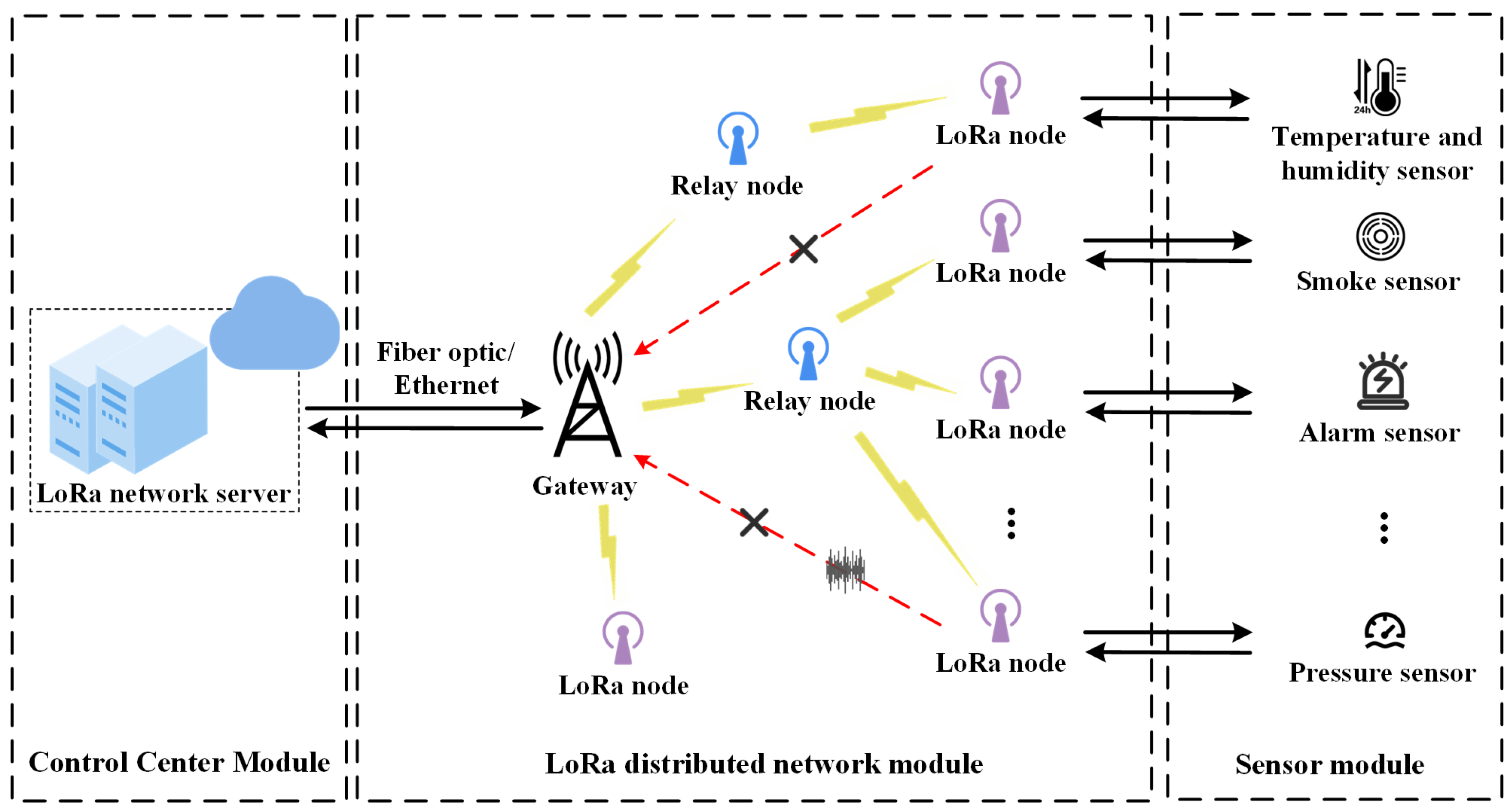
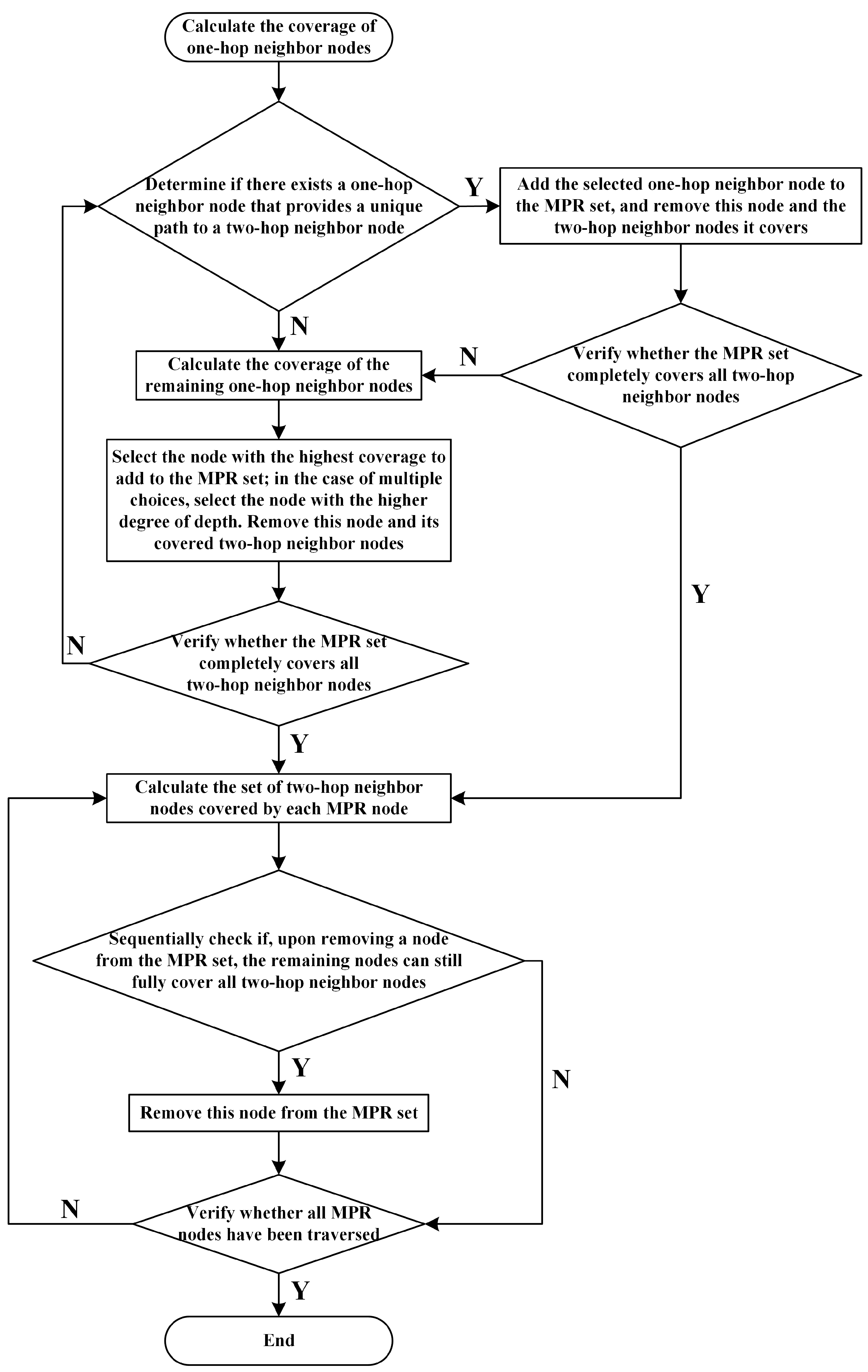
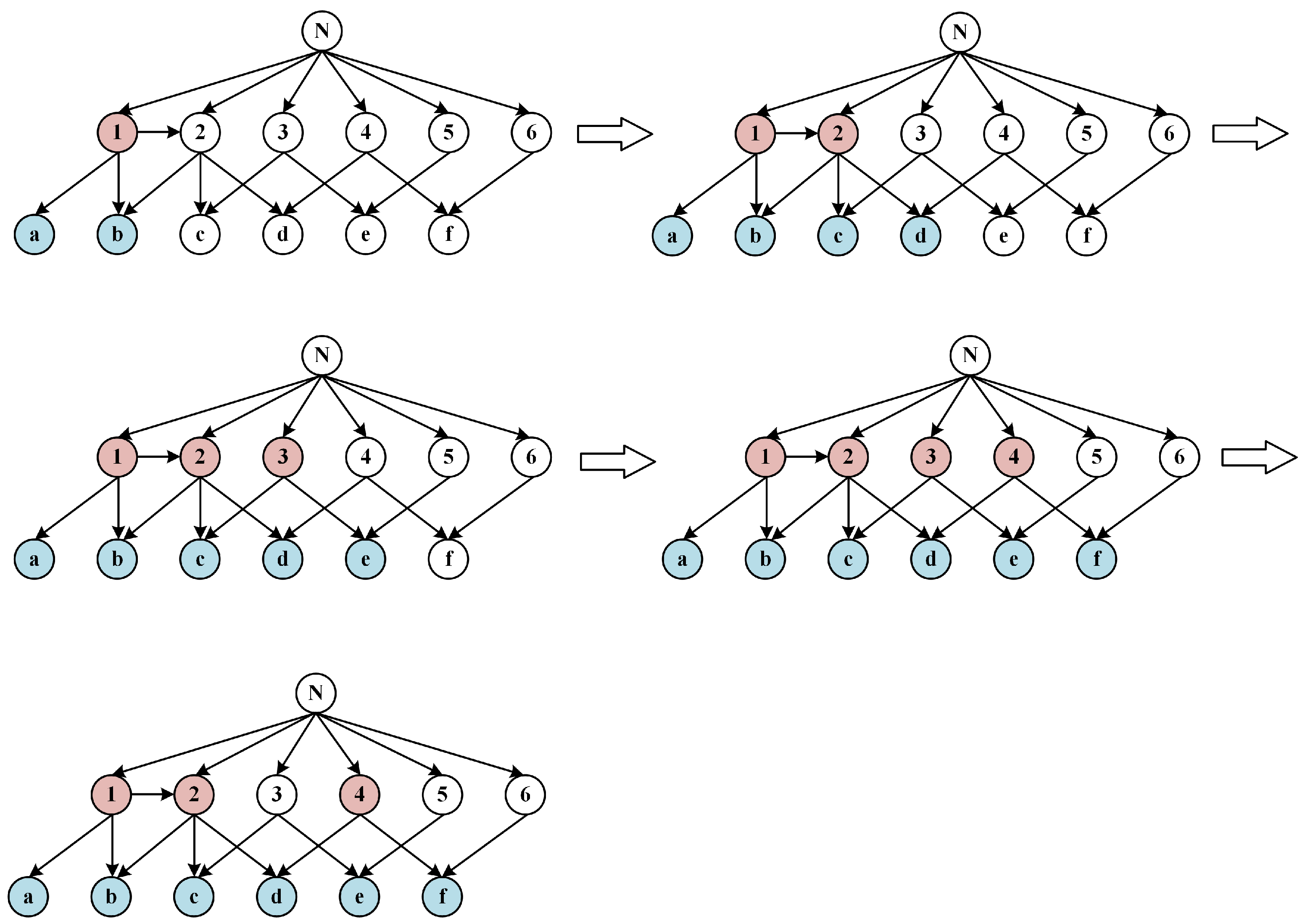
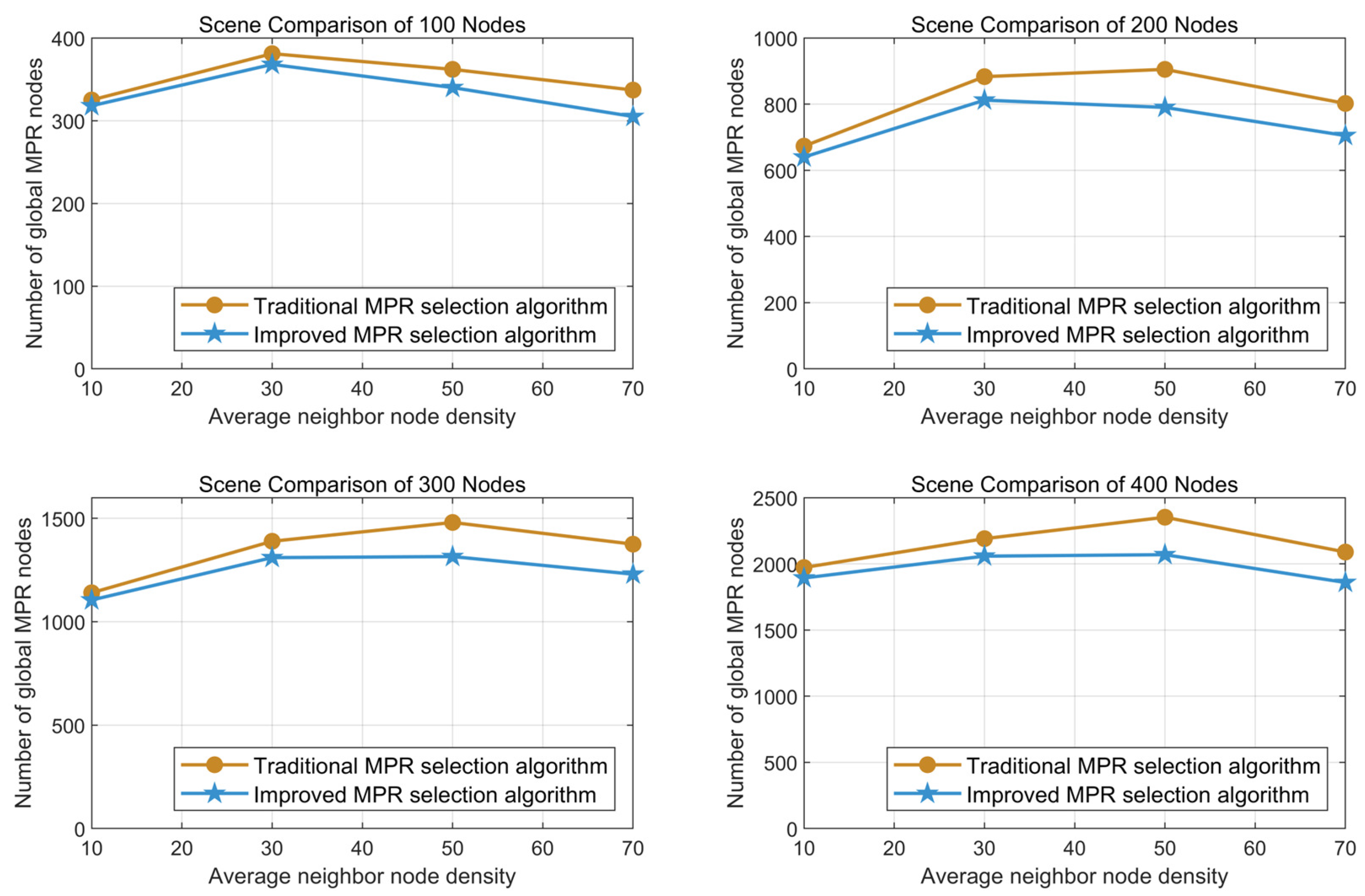
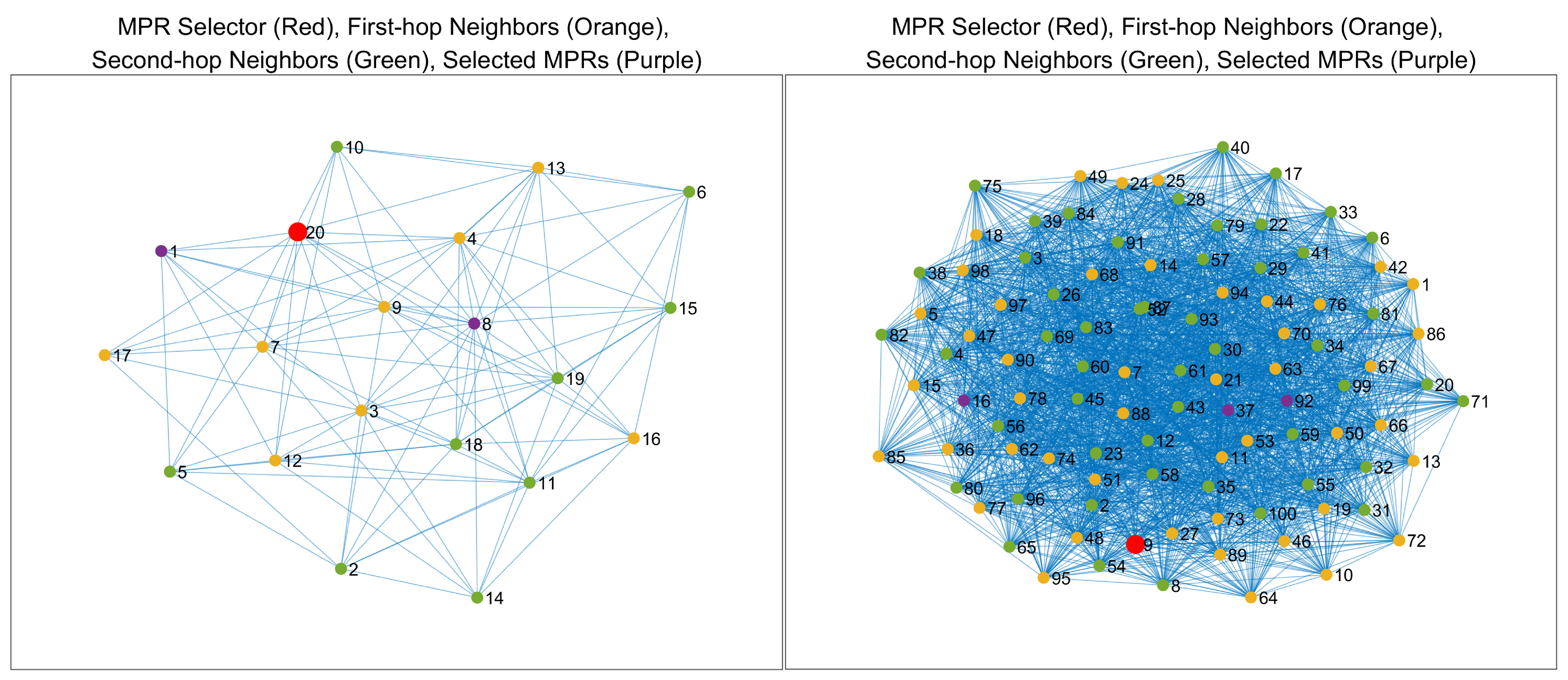


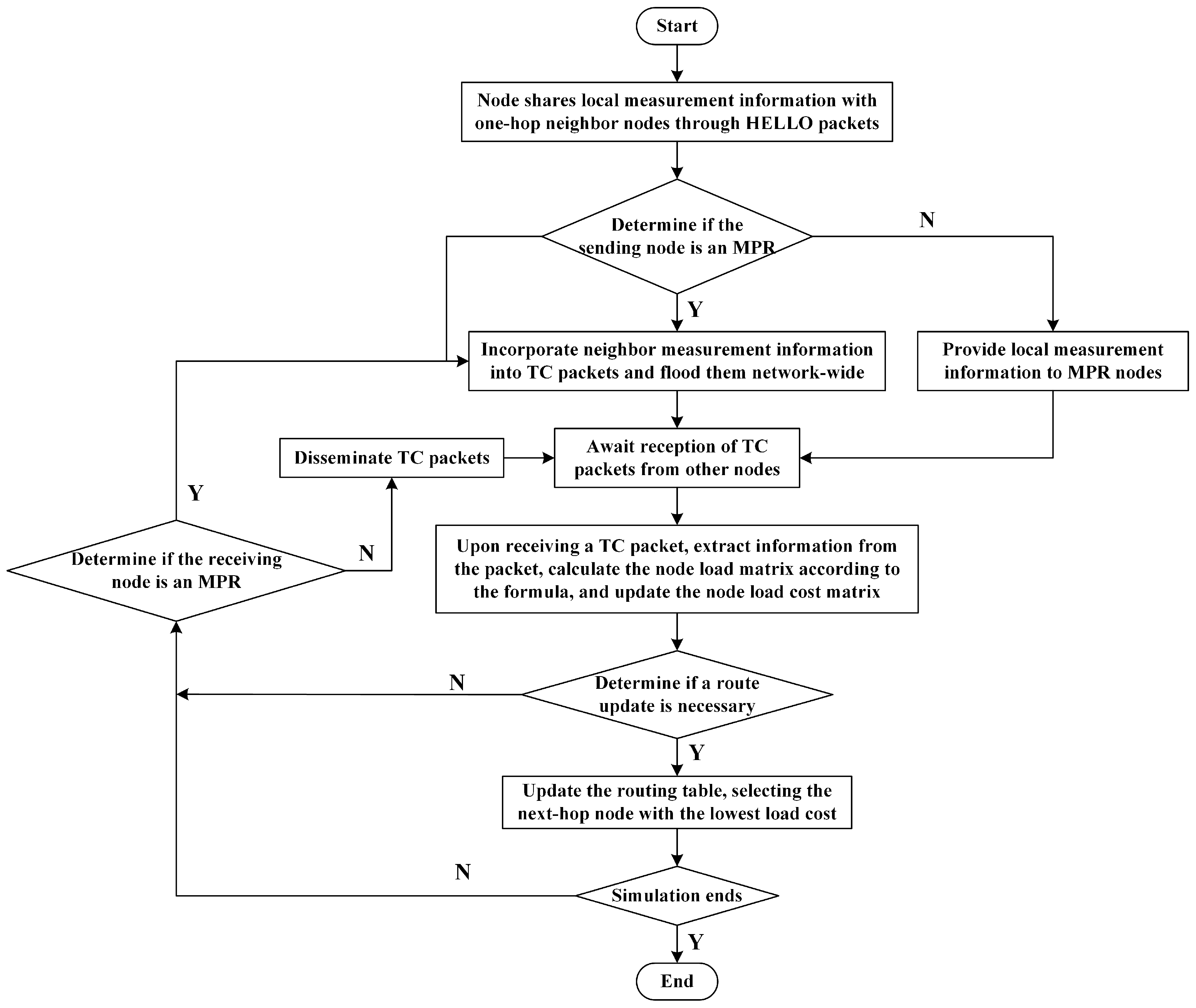
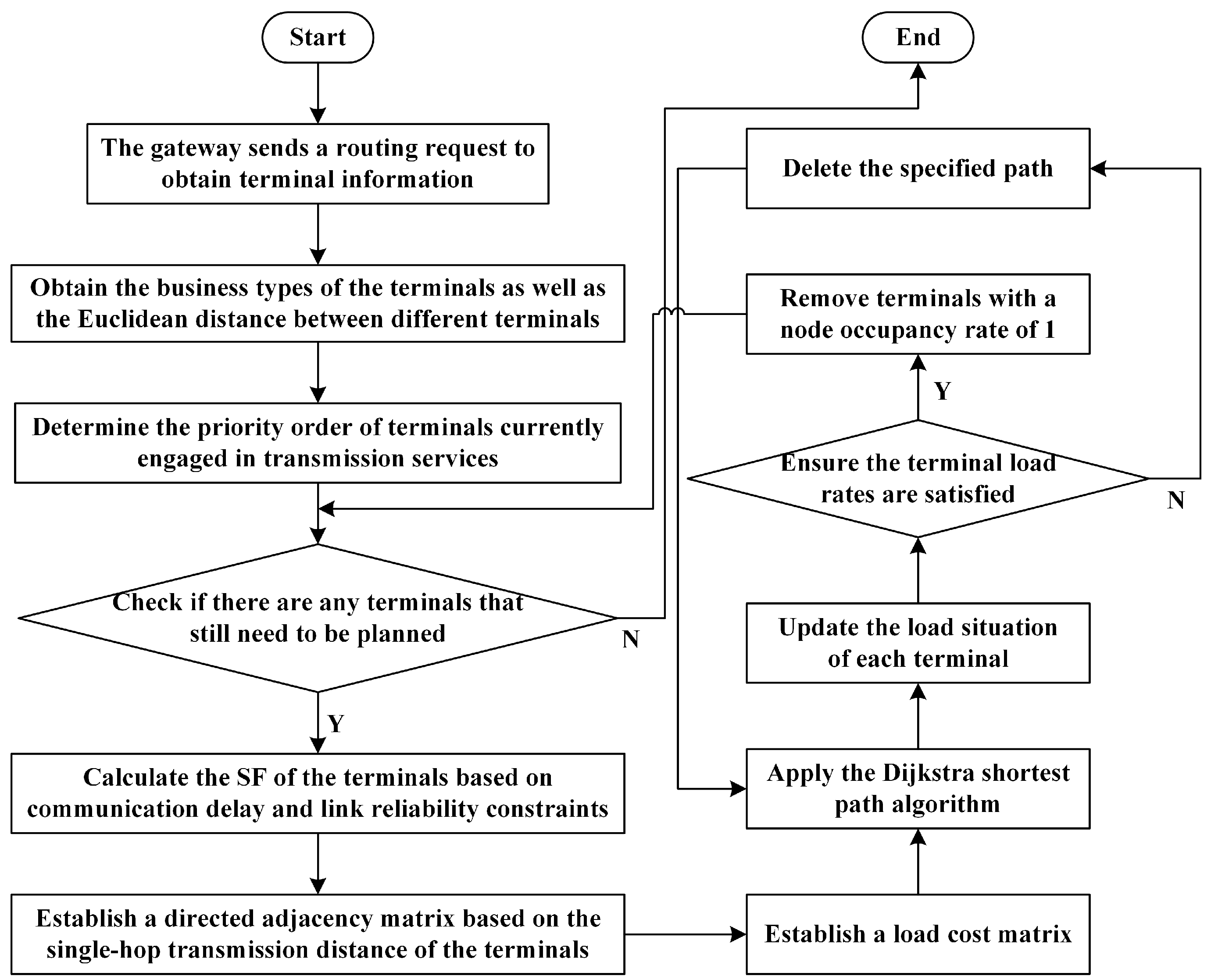
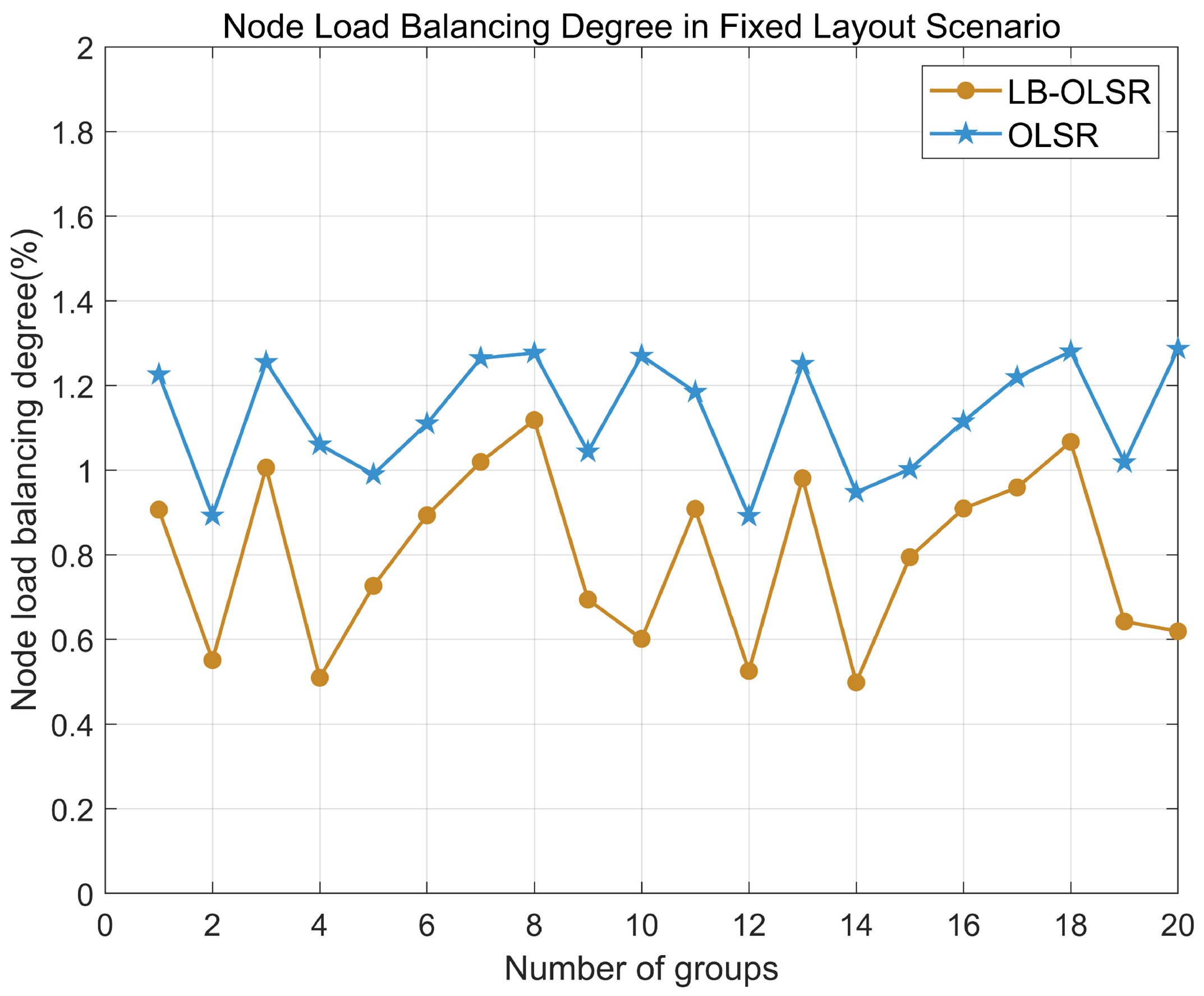


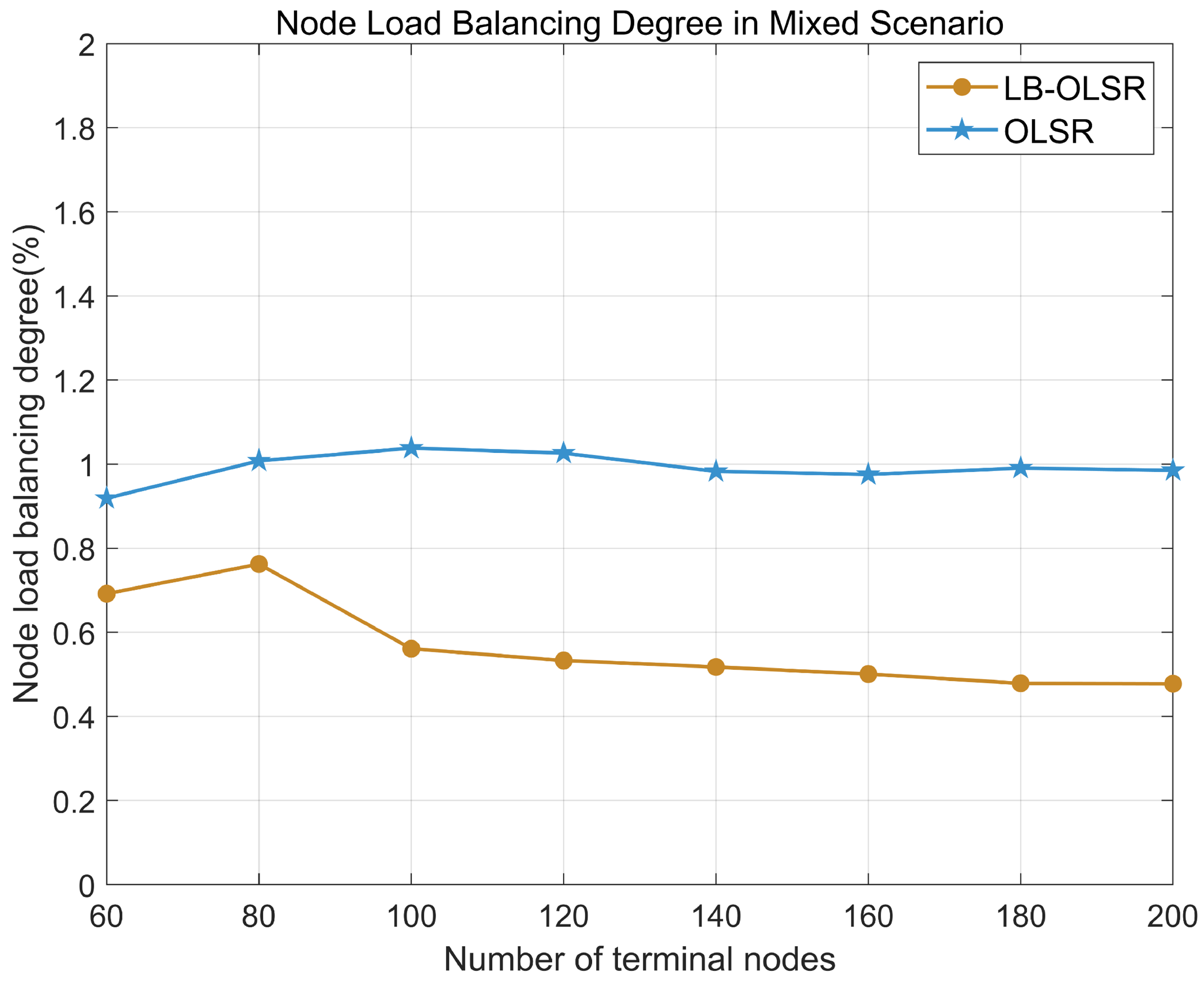
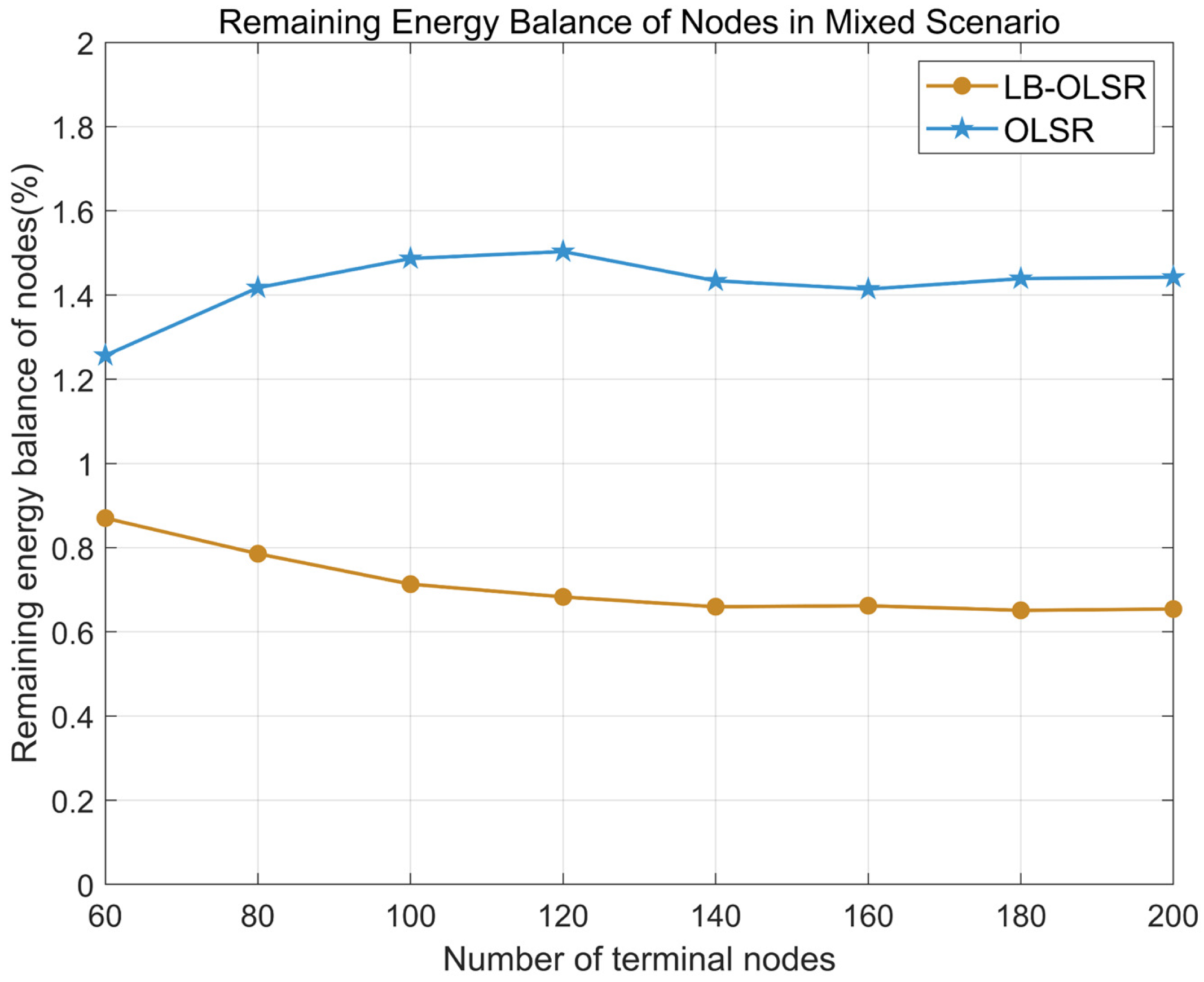
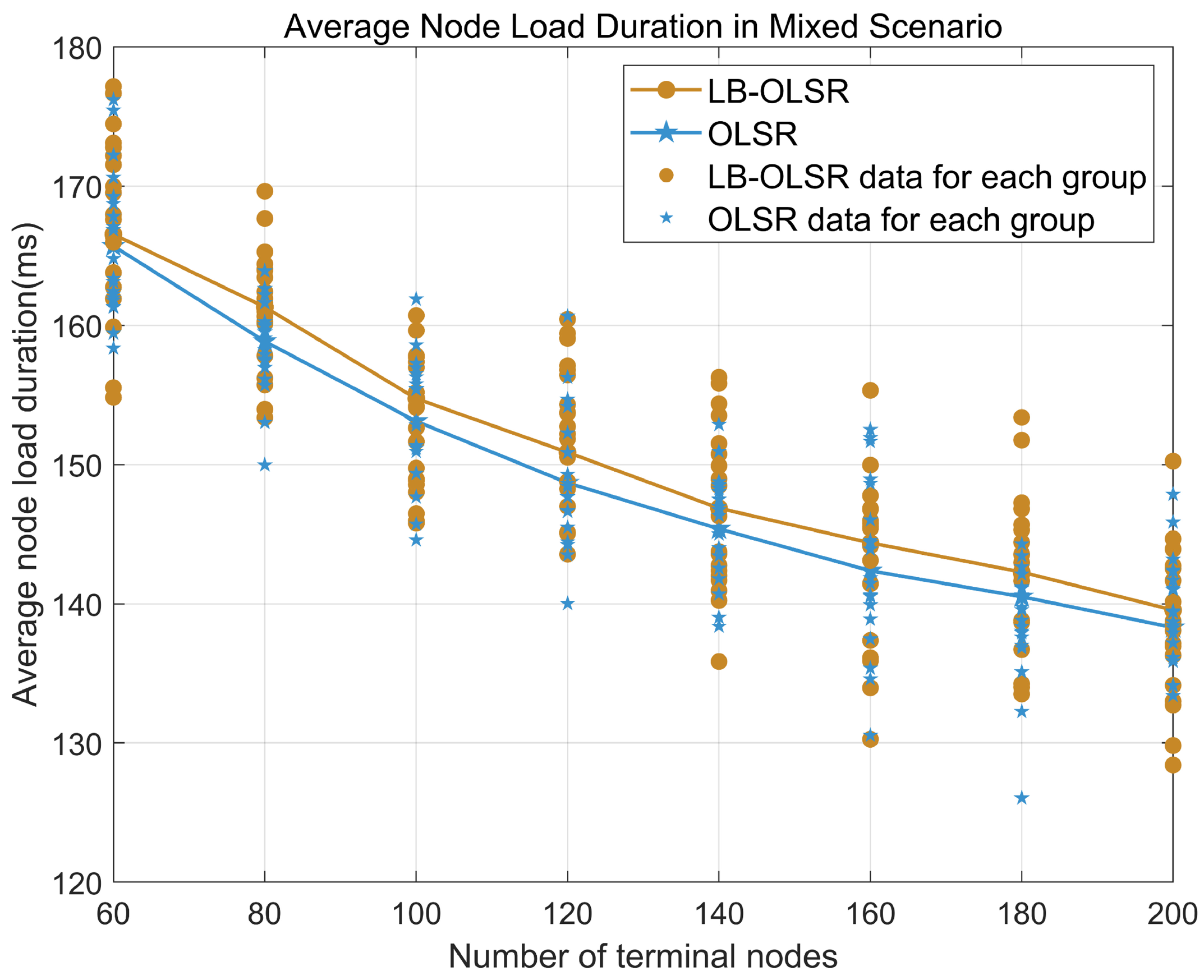

| Algorithm Parameter | Parameter Description |
|---|---|
| MPR selection nodes | |
| MPR node set | |
| Number of nodes in the MPR set | |
| Number of one-hop neighbors | |
| FN[i] | The i-th hop neighboring node |
| Number of two-hop neighbors | |
| SN[i] | The i-th two-hop neighboring node |
| Remaining available one-hop neighbors | |
| Remaining available two-hop neighbors | |
| Unique path between two-hop and one-hop neighbors | |
| Cov[i] | Two-hop neighbors covered by node i |
| Maximum coverage of node i | |
| Depth of node i | |
| Maximum depth of node i |
| Occupancy Rate | Low | Medium | High | |
|---|---|---|---|---|
| Load Rate | ||||
| Low | ||||
| Medium | ||||
| High | ||||
| Parameter Name | Parameter Value |
|---|---|
| Scenario spatial size | 100 × 50 × 18 |
| Number of end nodes | 60–200 |
| Number of aggregators | 1 |
| Number of simulations | 20 |
| BW/kHz | 125 |
| SF | 7–12 |
| Coding rate CR | 4/5 |
| Hello message interval/s | 5 |
| TC message interval/s | 8 |
| Business Type | Transmission Delay | Reliability | Success Rate | Business Proportion | Payload | Priority |
|---|---|---|---|---|---|---|
| Anomaly alarm | Low | High | 98% | 5% | 5 Byte | 1 |
| Control | Low | High | 95% | 20% | 10 Byte | 2 |
| Energy monitoring | Medium | Medium | 90% | 40% | 20 Byte | 3 |
| Environmental monitoring | Medium | Medium | 80% | 30% | 20 Byte | 4 |
| Other business | High | Medium | 80% | 5% | 10 Byte | 5 |
Disclaimer/Publisher’s Note: The statements, opinions and data contained in all publications are solely those of the individual author(s) and contributor(s) and not of MDPI and/or the editor(s). MDPI and/or the editor(s) disclaim responsibility for any injury to people or property resulting from any ideas, methods, instructions or products referred to in the content. |
© 2024 by the authors. Licensee MDPI, Basel, Switzerland. This article is an open access article distributed under the terms and conditions of the Creative Commons Attribution (CC BY) license (https://creativecommons.org/licenses/by/4.0/).
Share and Cite
Pang, S.; Lu, J.; Pan, R.; Wang, H.; Wang, X.; Ye, Z.; Feng, J. Optimizing Routing Protocol Design for Long-Range Distributed Multi-Hop Networks. Electronics 2024, 13, 3957. https://doi.org/10.3390/electronics13193957
Pang S, Lu J, Pan R, Wang H, Wang X, Ye Z, Feng J. Optimizing Routing Protocol Design for Long-Range Distributed Multi-Hop Networks. Electronics. 2024; 13(19):3957. https://doi.org/10.3390/electronics13193957
Chicago/Turabian StylePang, Shengli, Jing Lu, Ruoyu Pan, Honggang Wang, Xute Wang, Zhifan Ye, and Jingyi Feng. 2024. "Optimizing Routing Protocol Design for Long-Range Distributed Multi-Hop Networks" Electronics 13, no. 19: 3957. https://doi.org/10.3390/electronics13193957
APA StylePang, S., Lu, J., Pan, R., Wang, H., Wang, X., Ye, Z., & Feng, J. (2024). Optimizing Routing Protocol Design for Long-Range Distributed Multi-Hop Networks. Electronics, 13(19), 3957. https://doi.org/10.3390/electronics13193957






